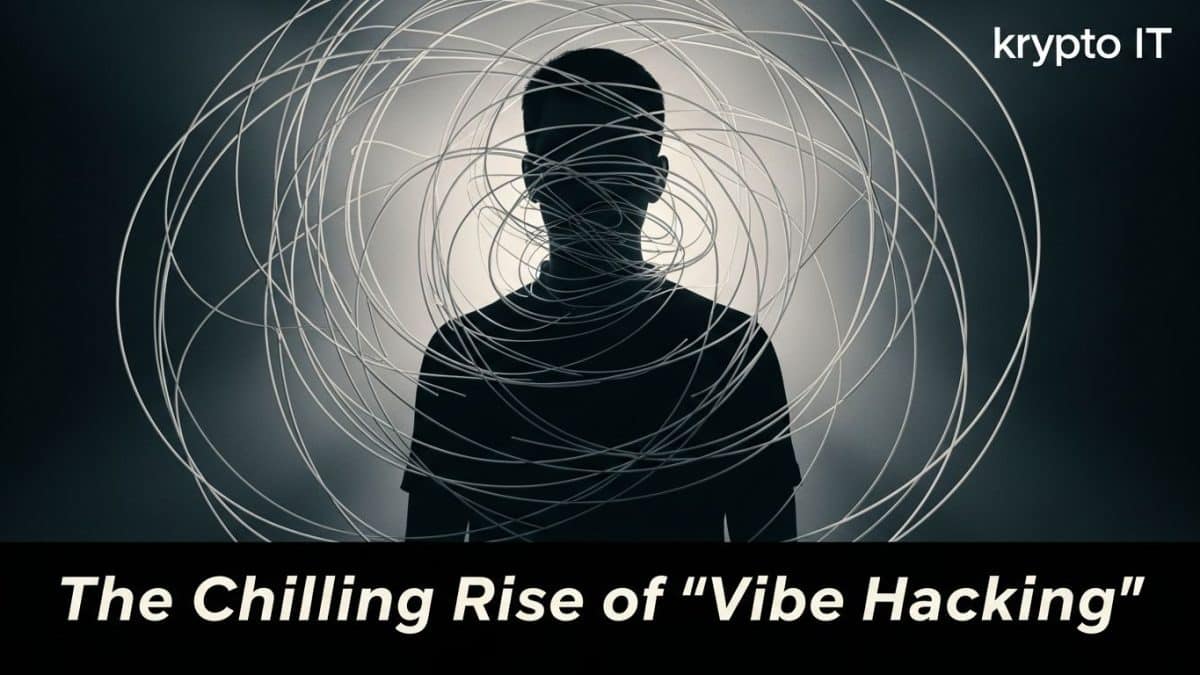
Data Privacy: More Than Just Compliance
June 4, 2025
Remote Work: Securing Your Distributed Team
June 7, 2025Why Emotional Manipulation is Your Business’s Next Big Cyber Threat
In the evolving landscape of cyber threats, attackers are constantly finding new ways to exploit vulnerabilities – and increasingly, those vulnerabilities are human. While we often focus on technical defenses, a disturbing new frontier has emerged: Vibe Hacking. This isn’t about breaking into systems; it’s about breaking into minds, manipulating emotions, and exploiting trust to achieve malicious ends. For Small and Medium-sized Businesses (SMBs) in Houston, understanding this subtle yet potent form of social engineering is critical, as it can bypass even the most robust technical safeguards.
Vibe hacking is less about code and more about coercion, less about algorithms and more about influence. It preys on human psychology, making it incredibly difficult to detect with traditional security tools.
What is ‘Vibe Hacking’?
‘Vibe hacking’ is a nuanced form of social engineering that goes beyond simple phishing. It’s about meticulously understanding and manipulating the emotional or psychological state (the “vibe”) of an individual or an organization to gain access, information, or control. Instead of sending a generic, urgent email, a vibe hacker builds a scenario, creates a false sense of rapport, urgency, authority, or even shared understanding to lower a victim’s guard and induce them to act against their best interests.
Think of it as advanced emotional engineering. It leverages:
- Emotional Triggers: Fear, urgency, curiosity, helpfulness, desire for validation, or even professional ambition.
- Contextual Awareness: Hackers do their homework, learning about their target’s role, recent projects, internal jargon, and even personal details often gleaned from social media.
- Persona Crafting: Creating believable fake identities (e.g., a new executive, a technical support expert, a disgruntled employee, a critical vendor) that fit the “vibe” needed for the scam.
- Long-Game Play: Unlike quick-hit phishing, vibe hacking can involve sustained interactions, building a relationship or a narrative over days or even weeks.
- Exploiting Trust & Authority: Impersonating someone in a position of power or trust to bypass normal protocols.
Examples of Vibe Hacking in Action:
- The “New Executive” Scam: A hacker meticulously researches a company and identifies a senior executive (e.g., CFO, CEO). They then create a convincing fake email or communication profile for a new executive, perhaps one just announced internally. The “new exec” emails an unsuspecting employee (e.g., accounting, HR) with an urgent, off-the-books request – “I need this wire transfer expedited immediately for a critical acquisition, don’t follow usual protocol, I’m in a meeting,” or “Send me the updated employee payroll spreadsheet ASAP, my flight is leaving.” The urgency and perceived authority override established procedures.
- The “Tech Support” Impersonation: Instead of a generic pop-up, a hacker might call, claiming to be from your IT department, a well-known software vendor (Microsoft, Adobe), or even your internet service provider. They might sound friendly, helpful, and knowledgeable, expressing concern about a “critical vulnerability” they’ve detected on your system. They then guide you to install “updates” (malware), grant remote access, or provide credentials. The “vibe” is one of helpful, legitimate assistance.
- The “Urgent Vendor Change” Fraud: Posing as a long-standing vendor, the hacker informs your accounts payable department of a “new bank account” for payments, citing a recent merger or internal change. The email might look legitimate, use the vendor’s actual logo, and sound plausible. The “vibe” is routine business change.
- The “Compromised Colleague” Ploy: An attacker gains access to one employee’s email account. Instead of mass-spamming, they observe internal communications, learn the tone, and then send targeted emails to colleagues, referencing ongoing projects or internal jokes, but subtly nudging them to click a malicious link or transfer funds for a “time-sensitive” matter. The “vibe” is shared understanding and trusted colleague.
Why ‘Vibe Hacking’ is a Growing Threat for SMBs
- Limited Resources: SMBs often lack dedicated security awareness teams, comprehensive threat intelligence, or advanced AI-driven tools that can detect subtle social engineering.
- Closer-Knit Teams: While often a strength, close-knit environments can also be exploited. Employees might be more inclined to trust a “colleague” or “executive” without double-checking, especially if the request plays on a desire to be helpful or efficient.
- Less Formal Processes: SMBs may have less stringent internal protocols for verifying unusual requests, especially those from higher-ups or seemingly urgent situations.
- Increased Remote Work: Remote and hybrid work environments make it harder to physically verify requests, increasing reliance on digital communication where a vibe hack can flourish.
- Sophistication of Attackers: Cybercriminals are continuously refining their social engineering tactics, moving beyond easily recognizable bad grammar and suspicious links.
Defending Your Business Against Vibe Hacking
Combating vibe hacking requires a fundamental shift in defense – focusing on the human element as much as the technical.
- Security Awareness Training (Ongoing): This is paramount. Train employees to:
- Verify Everything: Teach them to double-check unusual requests, especially those involving money, sensitive data, or bypassing normal procedures.
- Question Urgency: Be skeptical of requests demanding immediate action without normal vetting.
- Look Beyond the Sender Name: Teach them to inspect email headers, sender addresses, and link destinations carefully.
- Use Out-of-Band Verification: If an email or message seems off, pick up the phone and call the supposed sender using a known number (not one provided in the suspicious message) to verify the request.
- Report Suspicion: Create a culture where employees feel safe and empowered to report anything that feels “off.”
- Strong Internal Protocols: Implement and enforce clear procedures for financial transfers, data sharing, and granting system access. Ensure multiple approvals are required for high-value transactions.
- Multi-Factor Authentication (MFA): Even if an attacker gains credentials through social engineering, MFA acts as a critical second line of defense.
- Least Privilege Access: Limit what employees can access. If a compromised account has minimal permissions, the damage an attacker can inflict is reduced.
- Robust Email Security: Implement advanced email filtering solutions that can detect sophisticated phishing attempts, even those without obvious malicious links.
- Regular Communication & Updates: Keep employees informed about new social engineering tactics and relevant incidents, even if they don’t directly affect your company.
Krypto IT understands that your employees are both your greatest asset and your most vulnerable point. We specialize in helping Houston SMBs build comprehensive cybersecurity strategies that integrate robust technical defenses with essential human-centric training to combat the rising tide of vibe hacking.
Don’t let emotional manipulation jeopardize your business.
Contact us today to schedule a free consultation and strengthen your human firewall against the subtle yet devastating power of vibe hacking.




